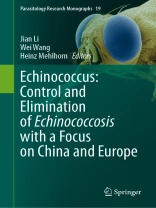This volume provides a comprehensive overview of human echinococcosis, a zoonotic disease caused by tapeworm parasites of the genus Echinococcus. Both cystic- (hydatid disease) and alveolar echinococcosis are included, covering the most important disease forms of medical and public health relevance. Presented findings focus China and Europe and are at the same time of global significance for clinical management and control programs under the One Health approach.
Echinococcosis is a relevant neglected tropical disease (NTD) and targeted for elimination by the WHO as a public health problem. The present book aids the critical actions for understanding the disease and its surveillance. In addition to fundamental information on tapeworm epidemiology, biology and immunopathogenesis, the chapters spotlight details on ultrasound diagnosis and staging, CT and MRI imaging. Moreover, molecular diagnostic tools, novel chemotherapeutics, and current vaccine research are discussed.
The book is a valuable resource for human and veterinary medicine considering the Sustainable Development Goals research (SDG 3: Good Health and Well-being). Scientists, students, and medical professionals will find significant content on animal reservoirs, parasite transmission, prevention and treatment options.
İçerik tablosu
Chapter 1: Brief recognition history of Echinococcus tapeworm.- Chapter 2: Global epidemiology of echinococcosis: current status and future prospects.- Chapter 3: Alveolar and cystic echinococcosis in Central Europe: epidemiology, diagnosis, therapy and prophylaxis.- Chapter 4: Echinococcosis in China: epidemiology, burden of disease and economic impacts.- Chapter 5: Biology and hosts of Echinococcus species in China.- Chapter 6: Echinococcosis immune response, immunopathogenesis and immune evasion from the human host.- Chapter 7: Pathology and clinical features of echinococcosis.- Chapter 8: Diagnosis of echinococciasis: parasitological, immunological, and molecular tools.- Chapter 9: Light and electron microscopical aspects of stages of Echinococcus species around the world.- Chapter 10: CT and MR features of echinococcosis.- Chapter 11: Ultrasound in diagnosis of echinococcosis.- Chapter 12: Current treatments for echinococcosis: what we have.- Chapter 13: Novel chemotherapeutical approaches against echinococcosis – a Swiss view.- Chapter 14: Cross- and multidisciplinary interventions used for echinococcosis control.
Yazar hakkında
Jian Li, Ph D, is Professor at the Hubei University of Medicine in China and Master supervisor. His research interests encompass the epidemiology, drug resistance, and multi-omics (genomics, transcriptomics, proteomics, immunomics, metabolomics, and the microbiome) of parasites, as well as methods of rapid diagnosis using high throughput immunoscreening platforms and PCR-based tools and test strips.
Dr. Wei Wang is Associate Professor at the Jiangsu Institute of Parasitic Diseases, China. He is an expert in the field of infectious- and tropical diseases. His research interests focus on emerging and reemerging infectious diseases, neglected tropical diseases, and drug resistance. He has published more than 150 papers in international and national peer-reviewed journals, including The New England Journal of Medicine, The Lancet Infectious Diseases, Journal of Travel Medicine, Stem Cell Research & Therapy, The Journal of Infectious Diseases, and has published more than 10 book chapters.
Prof. Dr. Heinz Mehlhorn has retired from Düsseldorf University, was editor of the Springer journal Parasitology Research for 25 years and President of the German and World Societies of Parasitology and Protozoology. He has published 50 parasitology books, more than 100 scientific articles, and is currently chairman of a German company, which is developing safe products against parasites.












